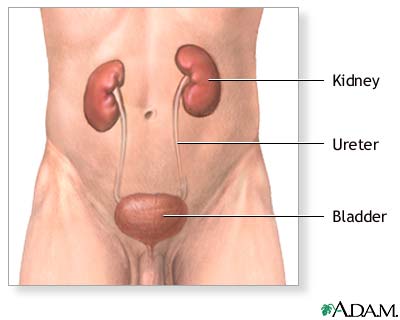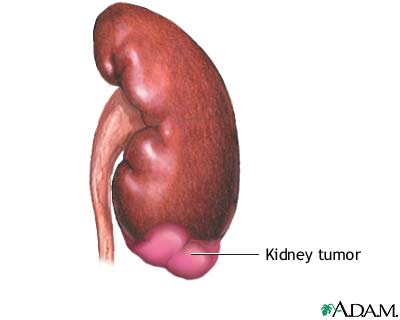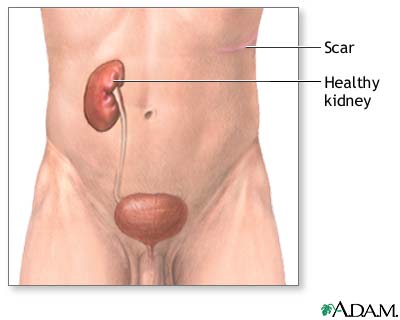Health Library
Kidney removal (nephrectomy) - series

Normal anatomy
The kidneys are paired organs that lie posterior to the abdomen, in the area of the lower back. The kidneys make urine, which is transported from the kidneys to the bladder by the ureters.

Indications
Nephrectomy may be recommended for:
- Kidney deformities (birth defects: congenital abnormalities)
- Injury (trauma)
- Disease
- Infection
- Hypertension
- Tumor
- Removal of kidney from donor for kidney transplant

Incision
While the patient is deep asleep and pain-free (general anesthesia), an incision is made in the abdomen or in the side of the abdomen (flank).

Procedure
The tube that carries urine from the kidney to the bladder (ureter) and the blood vessels are cut away from the kidney and the kidney is removed. The incision is then closed. This operation is called a nephrectomy.

Aftercare
Patients are generally in the hospital after surgery for 3 to 5 days. The removal of one kidney generally has no health consequences as long as the remaining kidney is functioning well. Some centers are now performing nephrectomies using laparoscopic surgical techniques.
BACK TO TOP
Review Date: 1/1/2023
Reviewed By: Kelly L. Stratton, MD, FACS, Associate Professor, Department of Urology, University of Oklahoma Health Sciences Center, Oklahoma City, OK. Also reviewed by David C. Dugdale, MD, Medical Director, Brenda Conaway, Editorial Director, and the A.D.A.M. Editorial team.
 | A.D.A.M., Inc. is accredited by URAC, for Health Content Provider (www.urac.org). URAC's accreditation program is an independent audit to verify that A.D.A.M. follows rigorous standards of quality and accountability. A.D.A.M. is among the first to achieve this important distinction for online health information and services. Learn more about A.D.A.M.'s editorial policy, editorial process and privacy policy. A.D.A.M. is also a founding member of Hi-Ethics. This site complies with the HONcode standard for trustworthy health information: verify here. |
The information provided herein should not be used during any medical emergency or for the diagnosis or treatment of any medical condition. A licensed medical professional should be consulted for diagnosis and treatment of any and all medical conditions. Links to other sites are provided for information only -- they do not constitute endorsements of those other sites. No warranty of any kind, either expressed or implied, is made as to the accuracy, reliability, timeliness, or correctness of any translations made by a third-party service of the information provided herein into any other language. © 1997- 2025 A.D.A.M., a business unit of Ebix, Inc. Any duplication or distribution of the information contained herein is strictly prohibited.
